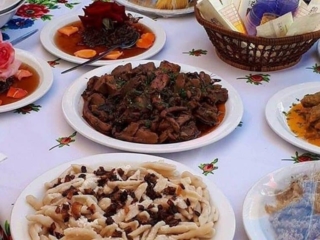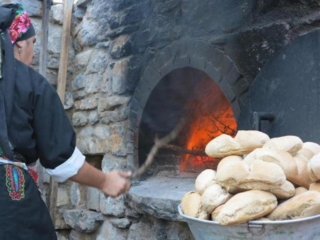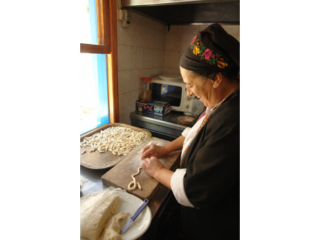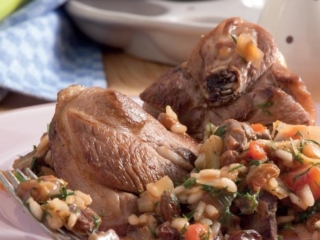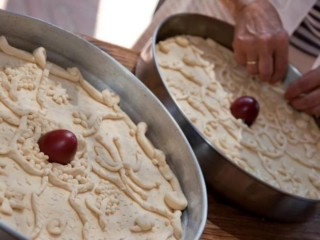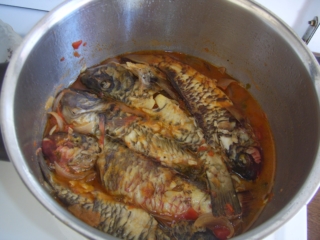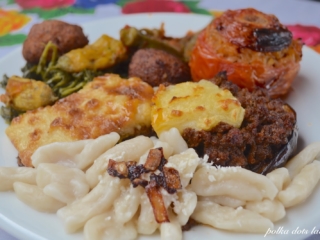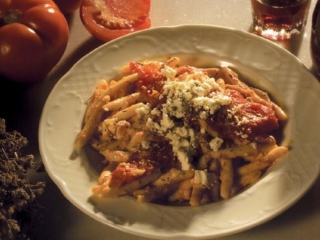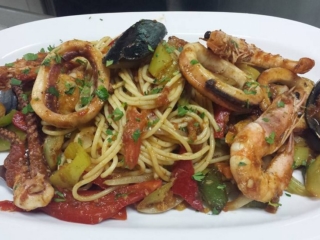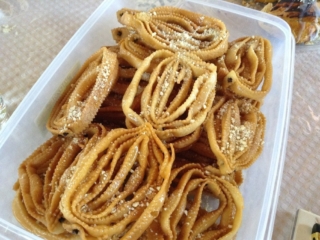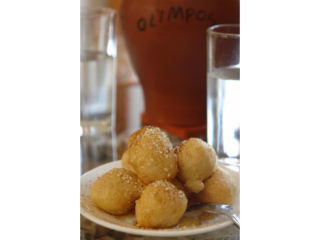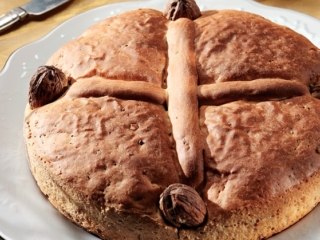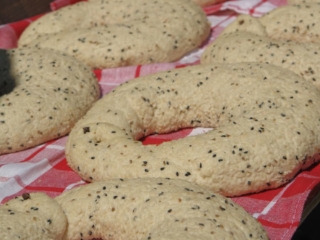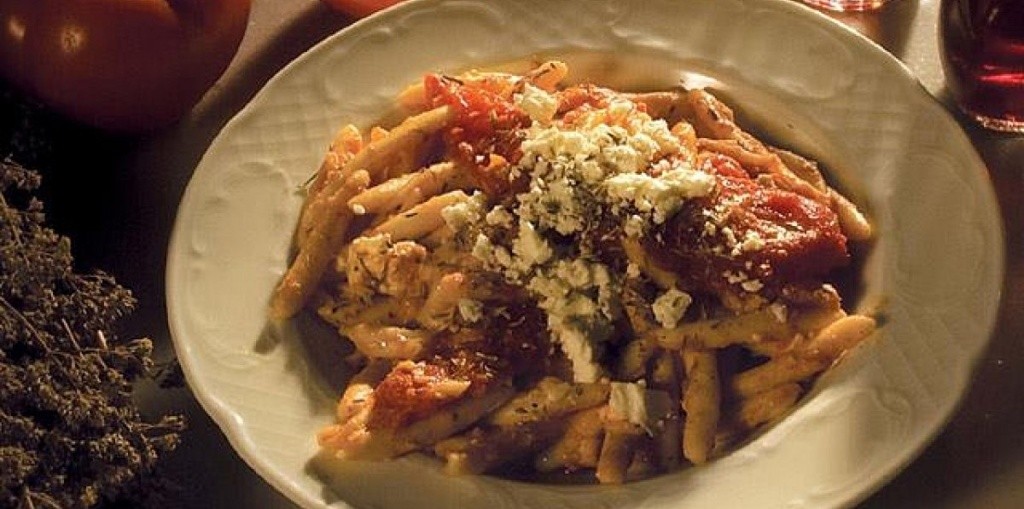
The land of Karpathos, although mountainous and wild, proved to be fertile, nourishing its inhabitants with rich products, grapes, citrus, oil and honey.
The women of Karpathos, even today, knead all together and bake the famous breads in traditional wood-fired ovens. They grind the wheat and barley in mills and make handmade pasta.
The local cuisine is based on pasta, with famous traditional pasta, made of flour and water. The original pasta cord is cut into 3 cm long sections, which are pressed well in the center with fingers, so that they get a dent. After drying a little they are boiled, burned with butter and served with “chopped” (roasted onion).
In the same way, pseudo-macarouna, which are bites of stale bread, are served, which boil until softened (from two to three minutes), in salted water.
Very wide variety of breads, on the island, of all kinds and flavors: Spicy, onion bread, crunchy rusks with mastic, cumin and white sesame, with cumin, nutmeg and black sesame.
The spicy onions are crispy, with plenty of spices and lots of onions. They are bagels with sesame, crispy and thin, sprinkled with plenty of black sesame. We meet them in neighboring Kasos.
The small cookies were once the wedding buns and were offered on a basket with sugar-cane. They are large round buns, inside of which are placed, vertically and horizontally twelve pasta strips, so that they cross to form small squares between them. Before baking, sprinkle with sesame seeds.
The anteriza are intestines stuffed which, after being thoroughly washed, are stuffed with rice, pieces of meat and many spices that are first sautéed in the pan. Then they sew them and place them in a pot with boiling water to bake. Then they fry them in a little oil to become crispy rolled pieces of pork, which boil in the pot along with pieces of pork fat “mildas”.
The meat is eaten plain as meze or tastes different dishes with pulses or omelets. The best pieces are usually fried or grilled with sesame on Christmas Day and baked on Christmas Eve together with Christopsomo, the essential supplement of Christmas, which is kneaded bread with cinnamon, mastic, cloves and is sprinkled with sesame. Usually it is in the shape of a cross.
A Christmas dish on the island is the thick of pork. It is a mixture consisting of pieces of meat and broth that comes from the boiling of the cleaned and “wrapped” (to burn the hair) head of the pig. Inside coexist harmoniously abundant spices (laurel, pepper, cumin) and of course, lemon juice.
Famous is the Byzantium, which is lamb or goat, stuffed with herbs and rice and simmered in a covered clay pot, making it the traditional Easter dish of the island. At Easter, women knead, even on Christokouloures, the characteristic “poles”, that is, thin salty “buns” in the shape of “eight”, with a red egg at one end. Easter dessert is also the cakes, made with a risen dough filled with soft sweet mizithra and flavored dill.
Another traditional recipe is ofto, the goat filled with rice, livers and herbs. It is baked in a wood oven for a whole night and is accompanied by the oak, which is yogurt from goat’s milk.
The local cuisine of the island is rich in pies: Vegetable pies, girls (in the winter filled with spinach and leek and in the summer with zucchini), onion pies, gras (vegetable pies with quite thick sheet, baked in a tin pan in the wood oven) and the ginger, a Christmas sweet, stuffed with raisins, made from grapes not consumed immediately, nor made into wine Yes. The raisins, ground, are the main component of the filling of “zimbilia”, a sweet pie, which together with nutmeg are wrapped in the dough sheet that they make at that time passed into a white and black sesame mixture and baked in the wood-fired ovens.
Wedding food o cartilage, that is, coarsely chopped wheat with meat and tomato. It can also be cooked with milk as a cream or even plain in water and before serving drizzled with sautéed onion. This food is also served at the feasts of the island.
Moschopougia is a traditional sweet, very common in all Dodecanese. In the shape of a crescent moon, they are stuffed with a mixture of different types of stuffing, containing mainly walnuts, almonds and sesame seeds, while on top they are sprinkled with powdered sugar.
Pads are a fry sweet, which is made in small pieces and syrup, while the sweet baklava is happy, with plain dough that is opened with a stick, fried in oil and then melted or foreign with almonds, nuts and many sheets of crust that give it a great height.
The carpenters become very thin, fried and served with honey. Sisamomeli (with honey and sesame) is offered at weddings for the bridegroom to get strength, but also to the guests.
Fish and seafood are abundant on the island, mainly a species of squid, the wild, which looks like squid, but also crabs, sea urchins, patellidae (butterflies), while the fish menula, which resembles the sardine, becomes salted.
Skaros is a fish that is abundant only in the Carpathian Sea and is cooked yachni or roast with plenty of olive oil and lemon.
The local cuisine includes of course the preserves of quince, fig, grape and sour cherry.
Raki and wine are never missing from the traditional table, since the rich vineyards in northern Karpathos produce excellent grapes, from which their famous wine is produced. Excellent quality, delicious and quite different. The most popular is the semi-sweet red wine, produced mainly in the mountainous Karpathos, Othos and Volada. The most famous varieties of the island are Athiri, Fokiano, but also the Cretan thrapsathiri and the Cycladic donkey. Of the white varieties, most are unknown such as roundabouts, karato, pumpkin, kotiko and syrinx.
The main element of the diet of the inhabitants of the island are the Karpathian cheeses, with the intense flavor. The most popular are the very soft manouli, the armyrotiri cheese, which as its name indicates is a very slow hard cheese, with which the locals usually accompany their pasta and pork.
